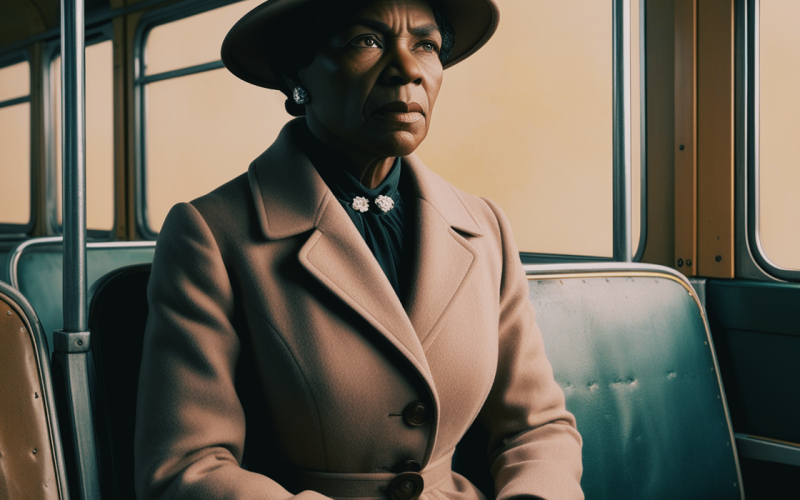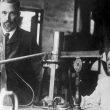Table of Contents Show
I. The Seeds of Defiance: Early Life in the Segregated South
In the small town of Tuskegee, Alabama, Rosa Louise McCauley was born on February 4, 1913, into a world shaped by the harsh realities of segregation and racial injustice. Her parents, James McCauley, a carpenter, and Leona Edwards, a schoolteacher, were part of a community that faced systemic discrimination, yet they instilled in their daughter a sense of dignity and self-worth that would carry her through the trials of her life.
Rosa’s childhood was marked by the pervasive racism of the Jim Crow South, where the color of one’s skin determined nearly every aspect of life. As a young girl, Rosa witnessed the Ku Klux Klan’s terror, their night rides a reminder of the ever-present threat of violence. Despite this, Rosa was taught to hold her head high, to stand firm in the face of injustice. Her family emphasized the importance of education, and Rosa excelled in her studies, though she was often forced to walk to school, passing by the buses that were reserved for white children.
The early experiences of segregation left an indelible mark on Rosa. The indignities she endured, from the separate and unequal facilities to the constant threat of violence, fueled a quiet but unyielding resolve. The McCauley family lived by a code of self-reliance and quiet resistance, and it was within this environment that Rosa’s sense of justice and her determination to challenge the status quo began to take root.
Rosa’s early life was also shaped by the strong women in her family, particularly her mother and grandmother, who were pillars of strength in a world that sought to diminish them. These women were not only role models but also taught Rosa the importance of standing up for what was right, even in the face of overwhelming odds. This foundation would prove crucial as Rosa moved from the small towns of Alabama to the front lines of the civil rights movement.
II. The Making of an Activist: Marriage and Early Involvement in Civil Rights
Rosa’s life took a pivotal turn in 1932 when she married Raymond Parks, a barber and an active member of the NAACP (National Association for the Advancement of Colored People). Raymond was deeply involved in efforts to defend the Scottsboro Boys, nine African American teenagers falsely accused of raping two white women. His commitment to justice and his willingness to risk his own safety for the cause deeply influenced Rosa, who began to see the fight for civil rights as her own.
The Parks’ marriage was a partnership not just of love but of shared purpose. Rosa and Raymond lived in Montgomery, Alabama, a city where the racial divide was stark and the fight for equality was becoming increasingly urgent. Rosa took a job as a seamstress, but her work extended far beyond the confines of the tailoring shop. She became active in the local NAACP chapter, serving as the secretary to E.D. Nixon, the chapter’s president, and one of the most prominent civil rights leaders in Montgomery.
Rosa’s role within the NAACP was crucial but largely behind the scenes. She documented cases of racial violence and injustice, helped organize meetings, and supported efforts to register African American voters, despite the severe restrictions imposed by Jim Crow laws. Her work required immense courage, as the NAACP was often targeted by local authorities and white supremacist groups. Rosa’s quiet determination and meticulous work were vital to the movement, even if they did not yet place her in the public eye.
It was during these years that Rosa began to see the full extent of the systemic racism that permeated every level of Southern society. The stories she recorded, of black men and women brutalized by police or denied basic rights, only strengthened her resolve. But it was her own experiences on the segregated buses of Montgomery that would soon propel her from the background of the movement into its very forefront.
III. A Moment of Resistance: The Montgomery Bus Boycott
On December 1, 1955, Rosa Parks boarded a city bus in Montgomery, tired after a long day of work. As the bus filled, the driver ordered Rosa and three other black passengers to give up their seats to white riders. In that moment, Rosa’s years of quiet defiance and her deep commitment to justice coalesced into a single act of resistance. She refused to move, a simple yet profound declaration that she would no longer submit to the dehumanizing demands of segregation.
Rosa’s arrest for violating the city’s segregation laws was not her first encounter with the racist policies of the Montgomery bus system. She had been ejected from a bus a decade earlier for refusing to enter through the back door after paying her fare at the front. But this time was different. Her arrest galvanized the black community in Montgomery, sparking the Montgomery Bus Boycott—a 381-day mass protest that would become one of the most significant campaigns of the civil rights movement.
Led by a then-unknown young preacher named Martin Luther King Jr., the boycott united tens of thousands of black residents in a sustained effort to end bus segregation. Rosa’s quiet act of defiance had lit the fuse, but the boycott was a collective effort that required the participation of an entire community. Despite threats, arrests, and violence, the black citizens of Montgomery walked, carpooled, and found other ways to get to work and school, crippling the city’s bus system and demonstrating the power of nonviolent resistance.
Rosa’s role in the boycott was both symbolic and substantive. As the “mother of the civil rights movement,” she became a figurehead, her image and story used to rally support for the cause. But behind the scenes, she continued her work with the NAACP, helping to organize and sustain the boycott. Her arrest and the subsequent boycott caught the attention of the national media, and Rosa Parks became a symbol of the larger struggle for civil rights.
IV. The Long Road to Justice: Life After the Boycott
The success of the Montgomery Bus Boycott marked a turning point in the civil rights movement, but for Rosa Parks, it was also the beginning of a long and difficult journey. Despite the victory in Montgomery, Rosa and her family faced severe repercussions. Both she and Raymond lost their jobs, and they were subjected to ongoing harassment and threats from white supremacists. The couple eventually moved to Detroit, Michigan, seeking refuge from the intense scrutiny and hostility they faced in the South.
In Detroit, Rosa found a new arena for her activism. The North was not immune to racial injustice, and Rosa quickly became involved in the struggle for civil rights in her new city. She worked for Congressman John Conyers, serving as his secretary and helping to address issues of housing, employment, and police brutality in Detroit’s black community. Rosa’s work was not as visible as her actions in Montgomery, but it was no less important. She continued to fight for justice, drawing on the same quiet strength that had defined her earlier activism.
Despite her ongoing efforts, Rosa often struggled with the economic hardships that had followed her from Montgomery. The fame she had gained from the bus boycott did not translate into financial security, and she lived modestly, often relying on the support of friends and fellow activists. Yet, Rosa remained steadfast in her commitment to the cause, her resolve unshaken by the challenges she faced.
Rosa’s life after the boycott was a testament to her enduring strength and resilience. She did not seek the spotlight, but she never wavered in her dedication to the fight for equality. Her work in Detroit, though less heralded, was a continuation of the principles that had guided her throughout her life—a belief in justice, dignity, and the power of collective action.
V. The Legacy of Courage: Impact and Recognition
Rosa Parks passed away on October 24, 2005, at the age of 92, leaving behind a legacy that continues to resonate across generations. Her quiet act of defiance on a Montgomery bus had sparked a movement that changed the course of American history, and her life of activism serves as a powerful reminder of the impact that one individual can have on the world.
Rosa’s legacy is not only defined by her role in the Montgomery Bus Boycott but by her lifelong commitment to justice and equality. She received numerous honors and awards during her lifetime, including the Presidential Medal of Freedom and the Congressional Gold Medal, yet she remained humble, always emphasizing that her actions were part of a larger struggle.
The impact of Rosa Parks extends far beyond the civil rights movement. Her courage inspired other movements for justice around the world, and her story is taught as a lesson in the power of peaceful resistance. The Rosa Parks Museum in Montgomery stands as a testament to her life and legacy, a place where future generations can learn about the woman whose simple act of defiance helped to change a nation.
Rosa Parks’ life was marked by moments of extraordinary courage, but it was her consistent, lifelong commitment to the cause of justice that truly set her apart. She was a woman who understood the power of quiet strength, who recognized that real change requires both individual acts of bravery and collective action. Her legacy is one of hope, resilience, and the unwavering belief that one person, standing firm in their convictions, can indeed make a difference.










